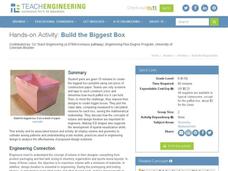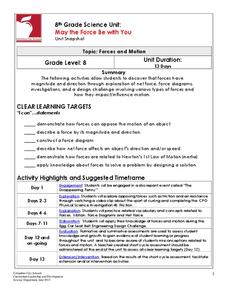Teach Engineering
Bouncing Balls
How high will it bounce? Groups determine the height different balls bounce off of different surfaces. By performing the necessary calculations, they determine the initial and final momentum of the balls. The included worksheet provides...
Curated OER
Gymnastics
This word search includes 30 gymnastics terms that may help your class learn relevant terms.
Curated OER
TE Lesson: GPS on the Move
Middle schoolers participate in a scavenger hunt and a drawing activity to examine the use of Global Positioning Systems including a handheld GPS receiver for personal navigation. They practice using the GPS receivers while collecting...
Curated OER
Ball Bounce Experiment
Students investigate different balls' abilities to bounce. They conduct a Ball Bounce Height Comparison and Ball Bounce Time Comparison, complete a worksheet, graph the results of their experiment, and answer investigating questions.
Teach Engineering
Energy Basics
Power up your lessons with an energetic resource. Scholars learn about work, force, energy, and power. They consider the relationships between these quantities through hockey puck scenarios and make calculations using formulas.
Teach Engineering
Let's Learn About Spatial Viz!
Can you see your class working on spatial visualization? The first installment of a five-part module introduces the concept of spatial visualization and provides a 12-question diagnostic assessment to test spatial visualization skills....
Teach Engineering
Build the Biggest Box
Boxing takes on a whole new meaning! The second installment of the three-part series has groups create lidless boxes from construction paper that can hold the most rice. After testing out their constructions, they build a new box....
Curated OER
Dream Building: Frank Lloyd Wright 1867 – 1959
As a part of an architecture unit, 10th graders research and draw a building's exterior. They view images of buildings Frank Lloyd Wright has designed, attend lecture, conduct research on architectural design, and then draw an exterior...
Curated OER
Hunt the Fact Monster Hunt #22
In this internet research worksheet, students use the internet to answer ten questions. Six of the questions are multiple choice, four are short answer questions.
Curated OER
Tides - The Ins and Outs of Tides
Get your junior oceanographers to generate tidal prediction graphs on an interactive website. They will feel like experts in the field, or shall we say, experts in the ocean! This is a brief, but worthwhile activity that could be used to...
Curated OER
Reading Comprehension 6: Level 9
Did you know that an acre of trees can absorb as much carbon dioxide as a car emits in 11,000 miles of driving? Such fun facts abound in a short reading comprehension passage detailing the benefits of parks and rooftop gardens. After...
It's About Time
Slinkies and Waves
Slinkies® are a great tool for visualizing waves. Pupils work in groups to create both transverse and longitudinal waves before using a polarizer to analyze the ways they are able to travel.
Columbus City Schools
May the Force Be with You
You won't have to force your classes to complete these engaging activities! Through exploration, young scientists learn that force has both magnitude and direction. They draw force diagrams, investigate force models, and complete a...
Curated OER
Bouncing Balls
Middle schoolers work together to examine how different types of balls react to colliding with different surfaces. They discover the difference between elastic and inelastic collisions. They practice calculating momentum as well.
Curated OER
Biomedical Devices for the Eyes
Students study the structures of the human eye. In this eye device lesson students examine different eye problems and devices that can help to resolve them.
Curated OER
Get Ready For Some Football
Sixth graders compare and contrast the totals from two national football teams for the year. Using the internet, they search for the information they need and create a data bar graph. They use the information they collected to answer...
Curated OER
Energy Balance: The Ins and Outs
Students review data from a 24-hour dietary recall to gain a practical understanding of information regarding energy intake and macronutrients.
Curated OER
Robot Gears
High schoolers build simple gear trains and record data to discover how to compute gear ratios. They investigate the definition of torque and how torque can be increased or decreased in a gear train.
Curated OER
Basic GPS
Young scholars discuss benefits of global positioning systems (GPS) and practice using them on the school grounds. A personal navigator, such as, the Garmin eTrex is necessary for this lesson plan.
National First Ladies' Library
Fashion Trends in the 1960s: Hippies, Flower Children, and Design
Middle schoolers use the Internet to research and examine clothing styles of 1960s, draw pictures of various clothing and accessories popular in that decade, trace images on top of foil tray or pan to design a stamp, and make a timeline...
Curated OER
Auto-Mania
In this history of automobiles worksheet, students answer 20 questions about the automobile industry, the changes that have taken place over the course of the auto industry's history and the current statistics about automobiles.
Curated OER
Build Your Own Hovercraft
Students construct a hovercraft following specific procedures. In this technology lesson, students explain the physics principles behind hovercraft. They compare and contrast this machine with the aircraft.
Curated OER
Reading Passages: Hispanic Astronauts
Children answer questions regarding the number of NASA astronauts that have hispanic heritage. They read a passage, and then answer 10 multiple choice questions. Note: The reading passage is not included.
Curated OER
Raptor Force
Students observe a video about pilots, their desired traits, and explore the similarities between a bird and an airplane. Using paper, wood or foam, they design create an aircraft to be flown in a competition to see which plane will fly...

























